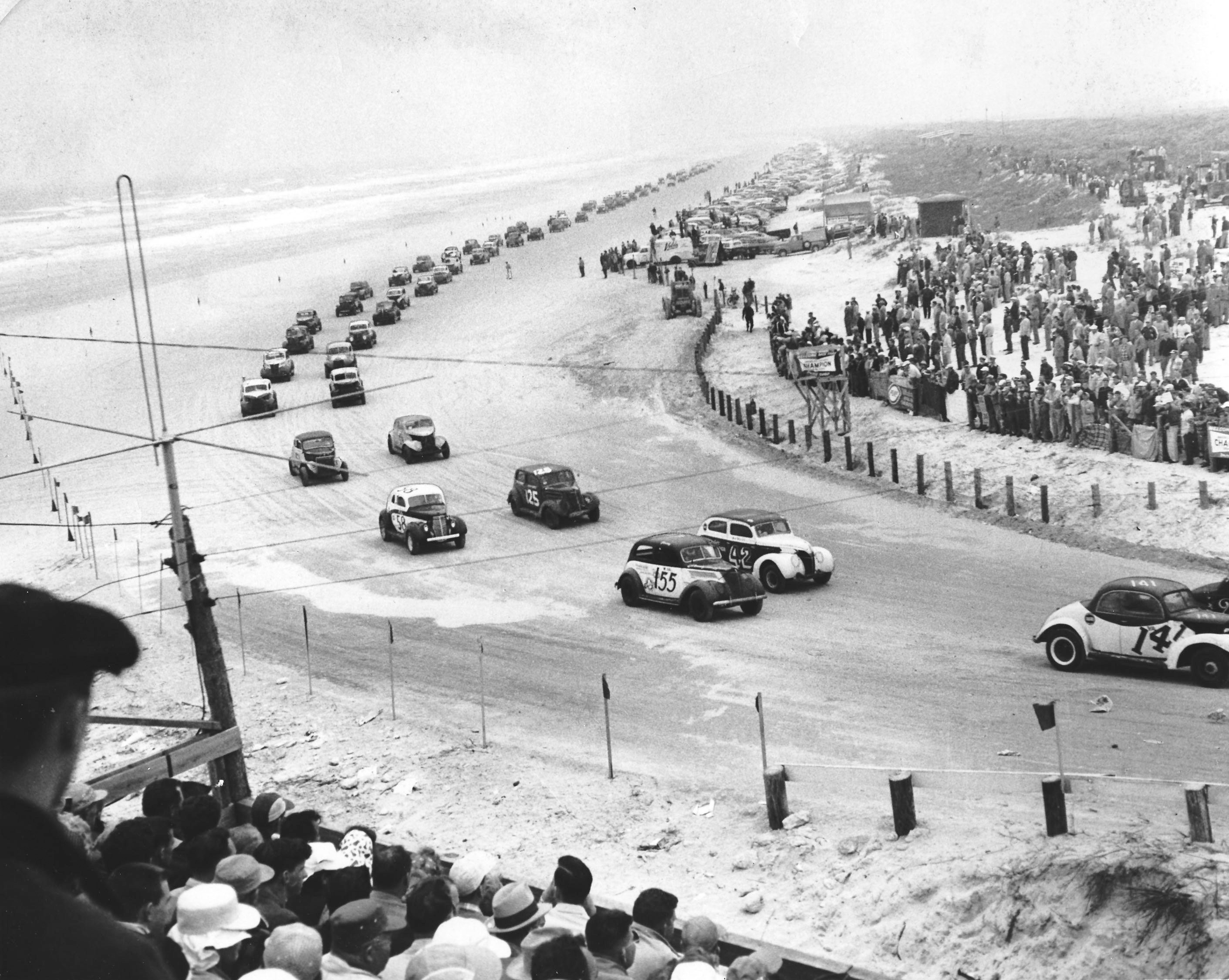From the Vault: Daytona Beach, 1953
by Tom Jensen February 04, 2022
Historic 1953 Speedweeks on the old Daytona Beach & Road Course was a sign of big things to come for NASCAR and the sport of stock-car racing.
In the old days, NASCAR didn’t just race at Daytona Beach, they raced on Daytona Beach. Literally.
From the time of NASCAR’s first officially sanctioned Modified Division points race on February 15, 1948, up until Daytona International Speedway opened in 1959, NASCAR competed on the Daytona Beach & Road Course, a 4.100-mile layout that ran south down Atlantic Avenue to a hairpin left-hand turn, then back north up the beach to another hairpin left-hander.
In 1953, NASCAR celebrated its fifth birthday with an action-packed Daytona Speedweeks that featured both the Modified Division (now Whelen Modified Tour) and the NASCAR Grand National Division (now premier series) competing on the hard-packed sands of Daytona Beach.
Daytona Speedweeks 1953 were notable for several reasons.
On Saturday, February 14, NASCAR fielded its largest starting grid ever, with a record 136 cars taking the green flag for the combined Modified-Sportsman race. Winning the race was a 28-year-old owner/driver/mechanic from Union, South Carolina, Hall of Famer Cotton Owens (2013), who would go on to win the Modified championship in 1953 and then repeat as Daytona winner and series champ again in 1954, a heady achievement. All told, nine future Hall of Famers competed in the Modified-Sportsman race.
The next day, 57 drivers lined up for the second Grand National Division race of the season. Included in the field was a little-known, 20-year-old racer who drove up from South Florida in a borrowed 1951 Hudson sedan. His name was Red Farmer, and he would go on to continuously hold a NASCAR competition license for the next 70 years, win four championships and be inducted into the NASCAR Hall of Fame Class of 2021.
The Grand National winner was North Carolina racer Bill Blair, who scored his second of three career premier series in his 1953 Oldsmobile.
Here are some rare photographs from Daytona Beach Speedweeks in 1953.

Photo courtesy of NASCAR Archives & Research Center via Getty Images
The record 136-car NASCAR Modified-Sportsman field roars to the green flag to start the 1953 race.

Photo courtesy of NASCAR Archives & Research Center via Getty Images
In both 1953 and ’54, Cotton Owens was both the Modified Division champion and the winner of the Modified-Sportsman race on the Daytona Beach & Road Course.

Photo courtesy of the NASCAR Hall of Fame Permanent Collection
Heading into the North Turn during the Modified-Sportsman race on the Daytona Beach & Road Course, Buddy Shuman (No. 89) led Dimitri Baltas.

Photo courtesy of the NASCAR Hall of Fame Permanent Collection
More Modified-Sportsman action, as Bobby Myers (No. 6A) led Gwyn Staley (No. 7) and another competitor.

Photo courtesy of the NASCAR Hall of Fame Permanent Collection
Heading north on the tightly packed white sand of the Daytona Beach & Road Course, Jack Farris and his Ford leads Ralph Moody temporarily. But Farris would eventually fall back to eighth place, while Moody would race his way up to second place, behind race winner Cotton Owens.

Photo courtesy of the NASCAR Hall of Fame Permanent Collection
Fans packed the Daytona Beach grandstands to see their favorite drivers, including Dink Widenhouse (No. B-29) and Hall of Famer Joe Weatherly (2015) in No. 9 do battle.

Photo courtesy of the NASCAR Hall of Fame Permanent Collection
Hall of Famer Fireball Roberts (2014), a Daytona Beach native, drove this pre-World War II Ford Coupe in the Modified-Sportsman race.

Photo courtesy of the NASCAR Hall of Fame Permanent Collection
Although Hall of Famer Herb Thomas (2013) and his iconic Fabulous Hudson Hornet finished fourth in the 1953 NASCAR Grand National Division race on the Daytona Beach & Road Course, by year end Thomas became NASCAR’s first two-time premier series champion, adding his second title two years after his first.

Photo courtesy of the NASCAR Hall of Fame Permanent Collection
Nicknamed “The Babe Ruth of Stock-Car Racing,” Hall of Famer Curtis Turner (2016) was one of NASCAR’s first true superstars. On the Daytona Beach & Road Course in 1953, Turned drove this Lincoln to a seventh-place finish.

Photo courtesy of the NASCAR Hall of Fame Permanent Collection
The 57-car Grand National Division field at Daytona Beach in 1953 included three Packards. Martinsville, Virginia, driver Fred Dove finished 48th in his No. 19 Packard. Dove would eventually post one top-five and 12 top-10 finishes in 47 career starts.













